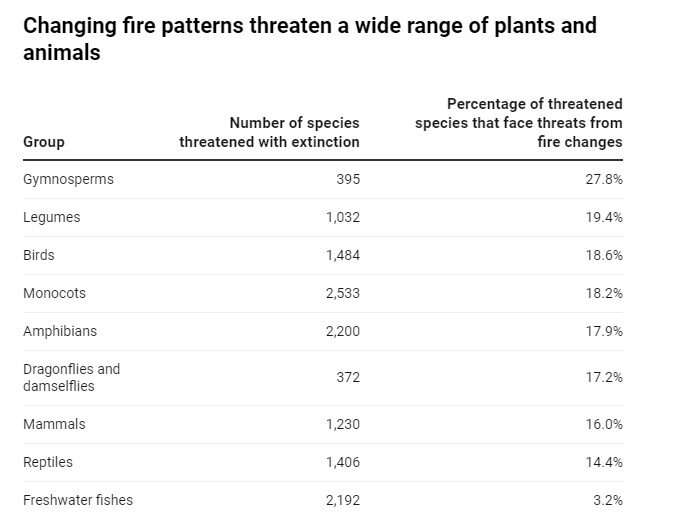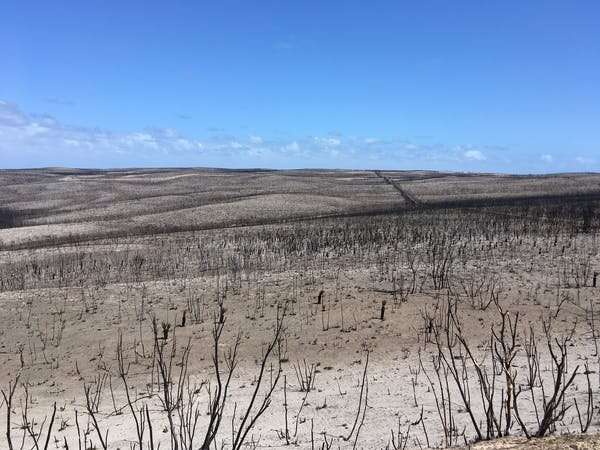Humans are changing fire patterns, and it's threatening 4,403 species with extinction

Last summer, many Australians were shocked to see fires sweep through the wet tropical rainforests of , where large and severe fires are almost unheard of. This is just one example of how human activities are changing fire patterns around the world, with huge consequences for wildlife.
In a major published in Science, we reveal how changes in fire activity threaten more than 4,400 species across the globe with extinction. This includes 19% of birds, 16% of mammals, 17% of dragonflies and 19% of legumes that are classified as critically endangered, endangered or vulnerable.
But, we also highlight the emerging ways we can help promote biodiversity and stop extinctions in this new era of fire. It starts with understanding what's causing these changes and what we can do to promote the "right" kind of fire.
How is fire activity changing?
Recent fires have burned ecosystems where wildfire has historically been rare or absent, from the tropical forests of , and to the tundra of the .
Exceptionally large and severe fires have also been observed in areas with a long history of fire. For example, the that burnt in eastern Australia during last summer's devastating bushfires was .
This extreme event came at a time when , with more extreme wildfires predicted in forests and shrublands , and western .
But fire activity isn't increasing everywhere. in countries such as , , and the have had fire activity reduced.
Extinction risk in a fiery world
Fire enables many to complete their life cycles, for a wide range of animals and maintains a . Many species are adapted to particular patterns of fire, —plants that release seeds into the resource-rich ash covering the ground after fire.
But changing how often fires occur and in what seasons can harm populations of species like these, and transform the ecosystems they rely on.
We from the (IUCN) and found that of the 29,304 land-based and freshwater species listed as threatened, modified fire regimes are a threat to more than 4,403.
Most are categorised as threatened by an increase in fire frequency or intensity.

For example, the endangered in semi-arid Australia is confined to isolated patches of habitat, which makes them vulnerable to large bushfires that can destroy entire local populations.
Likewise, the Kangaroo Island dunnart was listed as critically endangered before it lost 95% of its habitat in the devastating 2019-2020 bushfires.
However, some species and ecosystems are threatened when fire doesn't occur. Frequent fires are an of African savanna ecosystems and less fire activity can lead to shrub encroachment. This can displace wild herbivores such as wildebeest that prefer open areas.
How humans change fire regimes
There are three main ways humans are transforming fire activity: global climate change, land-use and the introduction of pest species.
modifies fire regimes fuels such as dry vegetation, ignitions such as lightning, and creating more extreme fire weather.
What's more, climate-induced fires can occur before the dominant tree species are old enough to produce seed, and this is reshaping forests in , and the .
Humans also alter fire regimes through farming, forestry, urbanisation and by intentionally starting or suppressing fires.
Introduced species can and ecosystems. For example, in savanna landscapes of Northern Australia, increases flammability and fire frequency. And invasive animals, such as red foxes and feral cats, prey on native animals exposed in recently burnt areas.
Importantly, cultural, social and economic changes these drivers. In Australia, the displacement of Indigenous peoples and their nuanced and purposeful use of fire has been linked with and is .

We need bolder conservation strategies
A suite of emerging actions—some established but receiving increasing attention, others new—could help us navigate this new fire era and save species from extinction. They include:
- —let some fires burn naturally in fire-prone ecosystems where fire has been absent for too long, suppressing only under specific conditions
- deployment of to enact targeted fire suppression and emergency conservation management, including providing animal refuges, reseeding to promote plant regeneration and large-scale habitat restoration
- reintroduction of that by reducing fuel loads, for the benefit of
- Indigenous fire stewardship, and continuing and reinstating in a modern context. This , and
- or , which comprises low-flammability such as parkland and open vegetation to help reduce fire spread, while providing refuges for wildlife.
Where to from here?
The will be valuable in helping navigate big decisions about new and changing ecosystems.
Empirical data and models can monitor and forecast changes in biodiversity. For example, has allowed University of Melbourne researchers to identify alternative strategies for introducing planned or prescribed burning that reduces the risk of large bushfires to koalas.
are also needed to meet the challenges ahead.
At the local and regional scale, Indigenous-led is an for fostering relationships between Indigenous and non-Indigenous organisations and communities around the world.
And international efforts to and limit global warming are crucial to reduce the risk of extreme fire events. With more extreme fire events ahead of us, learning to understand and adapt to changes in fire regimes has never been more important.
Provided by The Conversation
This article is republished from under a Creative Commons license. Read the .![]()





















